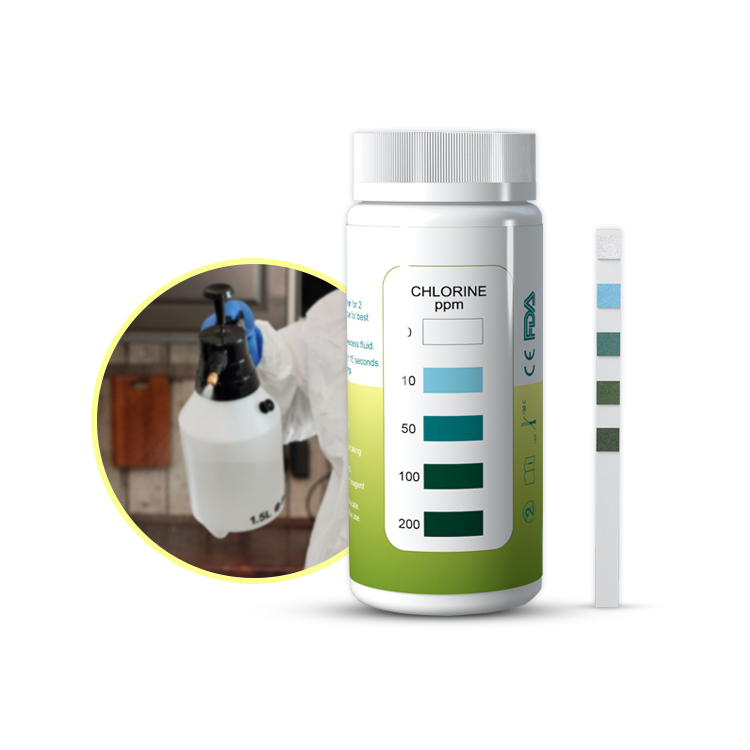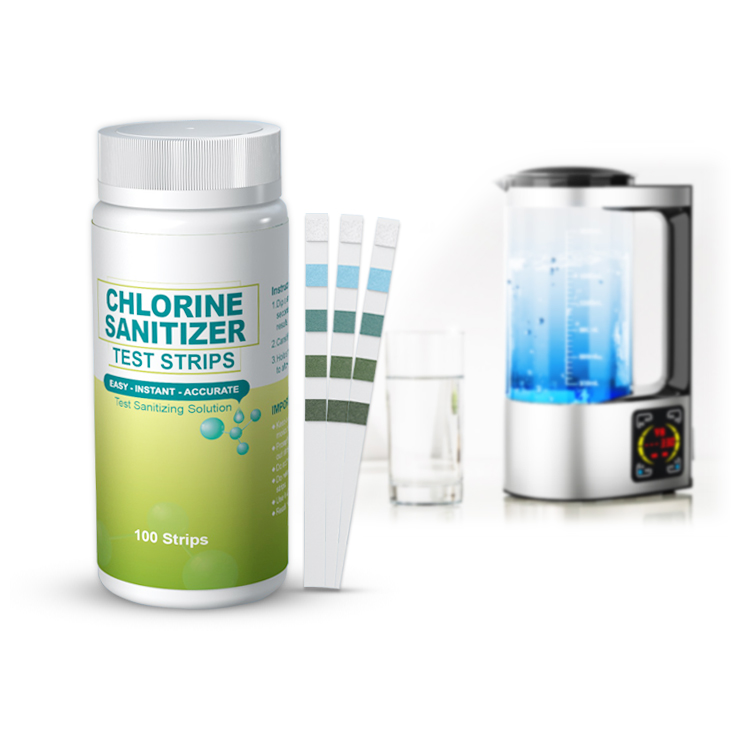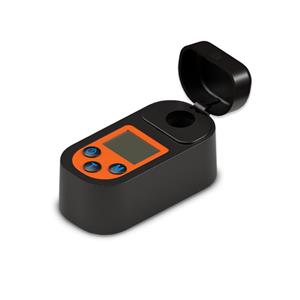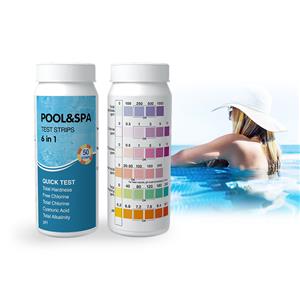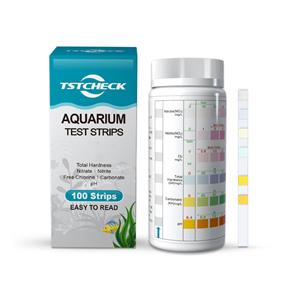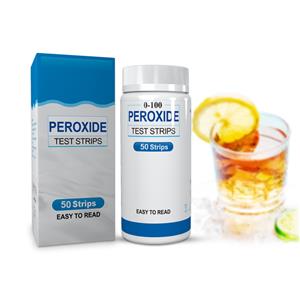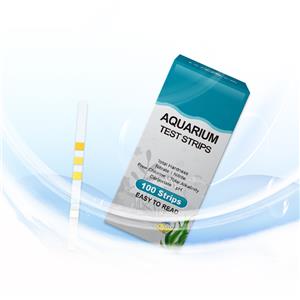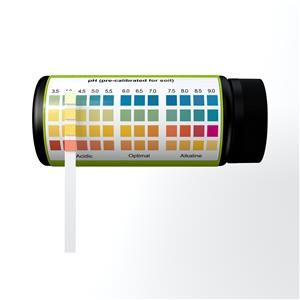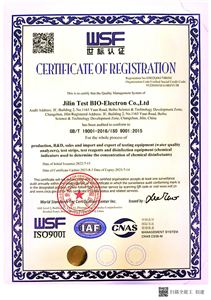Disinfectant chlorine test strips are used for water testing, restaurant, hospital.
Results in seconds,
Simple to use,
Bottle of 100 test strips with verified color chart bottle label for easy color matching.
Chlorine Test Strips: An Essential Tool for Chlorine Detection
1. Introduction
Chlorine is widely used in various industries and settings for its powerful disinfectant properties. In the food and beverage industry, especially in restaurants, chlorine - based sanitizers are commonly employed to ensure food safety by killing harmful bacteria, viruses, and other pathogens. Similarly, in general disinfection processes, such as in hospitals, households, and public facilities, chlorine - containing disinfectants like bleach play a crucial role. However, maintaining the correct concentration of chlorine is of utmost importance. Too little chlorine may result in ineffective disinfection, while excessive chlorine can lead to potential health risks, damage to equipment, and an unpleasant odor. This is where chlorine test strips and related products, including chlorine test kits, come into play. As a company dedicated to producing high - quality water testing products, we offer a range of chlorine test strips designed to meet the diverse needs of different applications.
2. Understanding Chlorine in Disinfection and Sanitization
2.1 The Role of Chlorine in Disinfection
Chlorine works as a disinfectant by oxidizing the cell walls and enzymes of microorganisms. When chlorine is added to water or used in a disinfectant solution, it forms hypochlorous acid (HOCl) and hypochlorite ions (OCl⁻). These reactive species are highly effective in destroying the structure and function of bacteria, viruses, and fungi. For example, in a restaurant kitchen, chlorine - based sanitizers are used to clean food contact surfaces such as countertops, cutting boards, and utensils. By killing pathogens, chlorine helps prevent the spread of food - borne illnesses, which is essential for maintaining a safe dining environment for customers.
2.2 Different Forms of Chlorine Used
Chlorine Gas: In large - scale water treatment plants, chlorine gas is sometimes used to disinfect water supplies. However, due to its toxicity and the need for specialized handling equipment, it is less commonly used in smaller - scale applications.
Sodium Hypochlorite (Bleach): Sodium hypochlorite is a common form of chlorine used in household bleach and many commercial disinfectants. It is relatively easy to handle and store, making it popular for a wide range of disinfection purposes. In restaurants, diluted bleach solutions are often used for sanitizing surfaces.
Chlorine Tablets and Granules: These are convenient forms of chlorine for applications where a slow - release of chlorine is required. For example, in swimming pools, chlorine tablets are added to maintain a consistent level of chlorine in the water.
3. How Chlorine Test Strips Work
3.1 Components of Chlorine Test Strips
Our chlorine test strips are carefully designed with specific components to ensure accurate and reliable chlorine detection.
Reagent - Impregnated Pad: The core of the test strip is the reagent - impregnated pad. This pad is made of a porous material, such as a special type of paper, which has been impregnated with chemical reagents that react specifically with chlorine. The reagents are chosen based on their ability to form a visible color change in the presence of chlorine.
Backing Material: The reagent - impregnated pad is attached to a sturdy backing material, usually made of plastic or a thick, non - reactive paper. The backing material provides support to the test strip, making it easy to handle during the testing process. It also protects the reagent - impregnated pad from physical damage and helps in maintaining the integrity of the test strip.
3.2 The Chemical Reaction for Chlorine Detection
When the chlorine test strip is dipped into a solution containing chlorine, a chemical reaction occurs between the chlorine and the reagents on the test strip. For example, some test strips use reagents that react with chlorine to form a colored complex. In the case of free chlorine (the active form of chlorine in disinfection), the reaction may involve the oxidation of a specific compound on the test strip. The more chlorine present in the solution, the more pronounced the color change will be. This color change is then used to determine the concentration of chlorine in the solution.
3.3 Color - Comparison and Concentration Determination
After the test strip has been exposed to the chlorine - containing solution and the color change has occurred, the user compares the color of the test strip with a color - comparison chart provided with the test strips. The color - comparison chart is calibrated to show the corresponding chlorine concentrations for each color on the chart. The calibration is based on extensive laboratory testing and is designed to provide accurate and consistent results. By matching the color of the test strip to the closest color on the chart, the user can quickly and easily determine the concentration of chlorine in the solution. Some of our advanced chlorine test strips may also have a numerical scale printed directly on the strip, allowing for a more precise reading.
4. Types of Chlorine Test Strips
4.1 General - Purpose Chlorine Test Strips
Our general - purpose chlorine test strips are suitable for a wide range of applications. They are designed to detect both free chlorine and total chlorine (the sum of free chlorine and combined chlorine, which is chlorine that has reacted with other substances such as ammonia). These test strips can cover a broad range of chlorine concentrations, typically from 0 - 10 ppm (parts per million) or even higher, depending on the specific product. General - purpose test strips are ideal for use in restaurants, where they can be used to test the chlorine concentration in sanitizing solutions for food contact surfaces. They are also useful in households for checking the chlorine levels in bleach - based cleaning solutions.
4.2 Specialized Chlorine Test Strips
4.2.1 Restaurant Chlorine Test Strips
Restaurant chlorine test strips are specifically tailored to the needs of the food service industry. In a restaurant setting, strict hygiene standards must be met to ensure the safety of customers. These test strips are designed to quickly and accurately measure the chlorine concentration in sanitizing solutions used for cleaning food contact surfaces, such as dishes, glasses, and utensils. They often have a more sensitive range for detecting chlorine concentrations within the optimal range for food safety. For example, the ideal chlorine concentration for sanitizing food contact surfaces in a restaurant is typically around 50 - 200 ppm. Our restaurant - specific test strips are calibrated to provide accurate readings within this critical range.
4.2.2 Disinfectant Chlorine Test Strips
Disinfectant chlorine test strips are designed for use in various disinfection applications outside of the food service industry. This includes hospitals, schools, and public facilities. These test strips can be used to test the chlorine concentration in disinfectant solutions used to clean floors, walls, and other surfaces. They are often more rugged and may be able to withstand harsher environmental conditions compared to other types of test strips. For example, in a hospital, where there is a high risk of pathogen transmission, accurate chlorine testing is crucial. Disinfectant chlorine test strips can help ensure that the disinfectant solutions used are effective in killing harmful microorganisms.
4.2.3 Bleach Chlorine Test Strips
Bleach is a common and widely used disinfectant, especially in households. Bleach chlorine test strips are specifically designed to test the chlorine concentration in bleach solutions. Since bleach is often diluted before use, these test strips are calibrated to accurately measure the chlorine levels in diluted bleach. They are useful for ensuring that the bleach solution is neither too weak (resulting in ineffective disinfection) nor too strong (which can cause damage to surfaces and be a health hazard). For example, when using bleach to clean a bathroom, a homeowner can use these test strips to ensure that the bleach solution is at the right concentration for effective cleaning and disinfection.
5. Applications of Chlorine Test Strips and Sanitizers Chlorine Detection
5.1 Restaurants
Food Safety Compliance: In restaurants, maintaining proper chlorine levels in sanitizing solutions is not only a best practice but also a legal requirement in many regions. Our restaurant chlorine test strips enable restaurant owners and staff to easily check the chlorine concentration in sanitizing buckets or spray bottles. By ensuring that the chlorine concentration is within the recommended range, restaurants can effectively kill pathogens on food contact surfaces, reducing the risk of food - borne illnesses. This is essential for protecting the health of customers and maintaining the reputation of the restaurant.
Cost - Effective Sanitization: Using the right amount of chlorine in sanitizing solutions is also cost - effective. If the chlorine concentration is too high, it can lead to unnecessary waste of the sanitizing product. On the other hand, if the concentration is too low, the sanitization process may need to be repeated, which can also be costly in terms of time and resources. Chlorine test strips help restaurants optimize the use of sanitizers, ensuring that they are using the right amount of chlorine for effective sanitization without over - or under - using the product.
5.2 Healthcare Facilities
Infection Control: In hospitals, clinics, and other healthcare facilities, preventing the spread of infections is of utmost importance. Chlorine - based disinfectants are widely used to clean patient rooms, operating theaters, and medical equipment. Our disinfectant chlorine test strips are used to monitor the chlorine concentration in these disinfectant solutions. By ensuring that the chlorine levels are appropriate, healthcare facilities can effectively kill a wide range of pathogens, including bacteria, viruses, and fungi. This helps in reducing the risk of hospital - acquired infections (HAIs), which can have serious consequences for patients' health.
5.3 Household Use
Cleaning and Disinfection: In households, bleach is a commonly used cleaning and disinfecting agent. Our bleach chlorine test strips allow homeowners to test the chlorine concentration in their bleach solutions. This is important for ensuring effective cleaning and disinfection of various surfaces in the home, such as kitchens, bathrooms, and floors. By using the right concentration of bleach, homeowners can kill germs and bacteria while also protecting the surfaces from damage caused by overly concentrated bleach solutions.
Child and Pet Safety: Maintaining the correct chlorine concentration in household cleaning products is also crucial for the safety of children and pets. If the chlorine concentration is too high, it can be harmful if ingested or if there is skin contact. By using chlorine test strips, homeowners can ensure that the bleach solutions they use are safe for use around children and pets.
6. Comparing Chlorine Test Strips with Chlorine Test Kits
6.1 Components and Functionality of Chlorine Test Kits
Chlorine test kits typically include multiple components in addition to test strips. They may come with test tubes, droppers, calibration solutions, and more detailed instruction manuals. Some test kits are designed to be more comprehensive and may include reagents for additional tests related to chlorine, such as tests for the presence of interfering substances that can affect the accuracy of chlorine measurement. For example, in a water treatment test kit, there may be components to test for the presence of ammonia, which can react with chlorine and form combined chlorine.
6.2 Advantages of Chlorine Test Kits
Higher Precision in Some Cases: Chlorine test kits may offer higher precision in certain applications. For example, some kits that include a digital chlorine meter can provide more accurate chlorine readings, especially in the case of very low or very high chlorine concentrations. The use of calibration solutions in test kits can help ensure that the measurement is more reliable, as the meter can be calibrated to the specific conditions of the sample being tested.
Additional Information: As mentioned earlier, some chlorine test kits can provide additional information about the sample. In a water treatment test kit, for example, there may be components to test for the pH of the water, which can affect the effectiveness of chlorine disinfection. This can give a more comprehensive picture of the water quality and the performance of the chlorine - based disinfection process.
6.3 Disadvantages of Chlorine Test Kits
Complexity: Chlorine test kits are generally more complex to use compared to individual chlorine test strips. The presence of multiple components and the need for calibration (in the case of meters) require more steps in the testing process. This complexity may require some training or prior experience, especially for users who are not familiar with laboratory - like procedures.
Higher Cost: Due to the inclusion of multiple components and potentially more advanced technology, chlorine test kits are often more expensive than a simple pack of chlorine test strips. This higher cost may be a deterrent for some users, especially those who only need to perform basic chlorine tests occasionally.
6.4 When to Choose Test Strips vs. Test Kits
For Quick and Simple Checks: If quick, on - the - spot testing is required, and a general estimate of the chlorine concentration is sufficient, chlorine test strips are the better choice. For example, a restaurant worker who needs to quickly check the chlorine concentration in a sanitizing bucket during a busy shift can use test strips easily and cost - effectively.
For Precise and Comprehensive Analysis: When high precision is crucial, such as in a water treatment plant where accurate chlorine measurement is essential for ensuring the safety of the water supply, or when additional information about the sample is needed, chlorine test kits may be more appropriate. For example, in a laboratory setting where the impact of different factors on chlorine disinfection is being studied, a comprehensive test kit can provide more detailed data.
7. Storage and Shelf - Life of Chlorine Test Strips
7.1 Storage Conditions
Proper storage of chlorine test strips is essential to maintain their accuracy and functionality. Test strips should be stored in a cool, dry place away from direct sunlight and heat sources. High temperatures and humidity can cause the reagents on the test strips to degrade, leading to inaccurate results. They should be kept in their original packaging, which is often designed to protect them from moisture and air. Some test strip packages may also contain desiccant packets to further absorb any moisture and keep the strips in optimal condition. Additionally, test strips should be stored away from chemicals that could potentially react with the reagents and affect their performance.
7.2 Shelf - Life
The shelf - life of chlorine test strips can vary depending on the manufacturer and the storage conditions. Generally, most test strips have a shelf - life of 1 - 2 years when stored properly. However, it is important to check the expiration date printed on the packaging before using the test strips. Using expired test strips can lead to inaccurate results, which can have significant implications in applications such as food safety and infection control. In cases where the test strips have been stored in less - than - ideal conditions, their performance may degrade even before the expiration date, so it's crucial to be vigilant about storage.
8. Conclusion
Chlorine test strips, including restaurant chlorine test strips, disinfectant chlorine test strips, and bleach chlorine test strips, are essential tools for ensuring the proper use of chlorine in various disinfection and sanitization applications. As a leading manufacturer of water testing products, we are committed to providing high - quality chlorine test strips that are accurate, easy to use, and cost - effective. Whether it's in a restaurant, a healthcare facility, or a household, our chlorine test strips can help users maintain the correct chlorine concentration in their disinfectant solutions, ensuring effective disinfection and a safe environment. By understanding the different types of chlorine test strips, how they work, their applications, and their advantages and limitations compared to test kits, users can make informed decisions and choose the right product for their specific needs. With proper storage and usage, our chlorine test strips can be a reliable and valuable part of any disinfection and sanitization routine.
Factory or Trading Company
Factory.
We speicalize in producing water test strips for years.
...more

